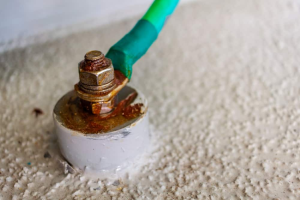How are grounding and bonding requirements in Class I, Division 1 and 2 locations different in the 2023 NEC?
Overview

Grounding and bonding are essential practices for ensuring safety and system integrity, as they establish safe fault current paths and prevent potential differences in electrical systems. NEC Section 501.30 specifies the grounding and bonding requirements for circuits in Class I, Division 1, and 2 locations. In the 2023 edition, this section was updated, leading to the creation of two distinct subsections (A) and (B). Subsection (A) outlines the provisions for grounding, while subsection (B) covers bonding requirements. This update was introduced to streamline and enhance the clarity of grounding and bonding requirements.
Applying the 2023 Code
Grounding and bonding are essential safety elements in electrical systems. Grounding involves establishing a connection to the earth to provide a path for ground fault currents to safely dissipate. Bonding, on the other hand, ensures that all metal parts of electrical equipment and enclosures are at the same electrical potential. Proper grounding and bonding practices are fundamental for electrical safety, equipment protection, fire prevention, and overall system integrity.
NEC Section 501.30 provides instructions for establishing grounding and bonding connections in circuits installed in Class I, Division 1, and Division 2 locations. However, previous editions grouped grounding and bonding provisions under shared subsections, causing confusion in implementation. The 2023 edition addresses this issue by revising the section with clearer language and creating two distinct subsections for grounding and bonding. This update aims to clarify the distinction between the applications of grounding and bonding.
What’s New for the 2023 NEC?
The comparison of 2020 NEC and 2023 NEC in terms of Section 501.30, is given in the Table below.
2020 NEC |
2023 NEC |
| 501.30 Grounding and Bonding, Class I, Divisions 1 and 2
Regardless of the voltage of the electrical system, wiring and equipment in Class I, Division 1 and 2 locations shall be grounded as specified in Article 250 and in accordance with the requirements of 501.30(A) and (B). (A) Bonding The locknut-bushing and double-locknut types of contacts shall not be depended on for bonding purposes, but bonding jumpers with proper fittings or other approved means of bonding shall be used. Such means of bonding shall apply to all intervening raceways, fittings, boxes, enclosures, and so forth between Class I locations and the point of grounding for service equipment or point of grounding of a separately derived system. Exception: The specific bonding means shall be required only to the nearest point where the grounded circuit conductor and the grounding electrode are connected together on the line side of the building or structure disconnecting means as specified in 250.32(B), provided the branch-circuit overcurrent protection is located on the load side of the disconnecting means. (B) Types of Equipment Grounding Conductors Flexible metal conduit and liquidtight flexible metal conduit shall include an equipment bonding jumper of the wire type in compliance with 250.102. Exception: In Class I, Division 2 locations, the bonding jumper shall be permitted to be deleted where all of the following conditions are met: (1) Listed liquidtight flexible metal conduit 1.8 m (6 ft) or less in length, with fittings listed for grounding, is used. (2) Overcurrent protection in the circuit is limited to 10 amperes or less. (3) The load is not a power utilization load.
|
501.30 Grounding and Bonding
Regardless of the voltage of the electrical system, wiring systems and equipment shall comply with 501.30(A) and (B). (A) Grounding Wiring systems and equipment shall be grounded in accordance with Part I and Part VI of Article 250, as applicable. (B) Bonding Bonding shall comply with Part I and Part V of Article 250, as applicable, and 501.30(B)(1) and (B)(2). (1) Specific Bonding Means Bonding shall comply with 501.30(B)(1)(a) and (B)(1)(b). (a) The locknut-bushing and double-locknut types of contacts shall not be depended on for bonding purposes, but bonding jumpers with identified fittings or other approved means of bonding shall be used. These bonding means shall apply to all metal raceways, fittings, boxes, cable trays, and enclosures, and other parts of raceway systems between Class I locations and the point of grounding for service equipment or point of grounding for a separately derived system. Metal struts, angles, or channels provided for support and mechanical or physical protection as permitted in 335.4(5), 336.10(7)(c), or 722.135(C) shall be bonded in accordance with 250.102. (b) Where the branch-circuit overcurrent protection is located on the load side of the disconnecting means, the specific bonding means shall be permitted to end at the nearest point where the grounded circuit conductor and the grounding electrode conductor are connected together on the line side of the building or structure disconnecting means as specified in 250.32(B). (2) Flexible Metal Conduit and Liquidtight Flexible Metal Conduit Flexible metal conduit and liquidtight flexible metal conduit shall comply with 501.30(B)(2)(a) and (B)(2)(b). (a) Flexible metal conduit and liquidtight flexible metal conduit shall include an equipment bonding jumper of the wire type in accordance with 250.102. (b) In Class I, Division 2 locations, the bonding jumper shall not be required where all of the following conditions are met: (1) Listed liquidtight flexible metal conduit 1.8 m (6 ft) or less in length, with fittings listed for grounding, is used. (2) Overcurrent protection in the circuit is limited to 10 amperes or less. (3) The load is part of a meter, instrument, or relay circuit. |
